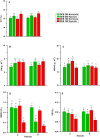Hypoxia, but not an electrolyte-imbalanced diet, reduces feed intake, growth and oxygen consumption in rainbow trout (Oncorhynchus mykiss)
- PMID: 29563578
- PMCID: PMC5862884
- DOI: 10.1038/s41598-018-23352-z
Hypoxia, but not an electrolyte-imbalanced diet, reduces feed intake, growth and oxygen consumption in rainbow trout (Oncorhynchus mykiss)
Abstract
Oxygen limitation and dietary imbalances are key aspects influencing feed intake (FI) and growth performance in cultured fish. This study investigated the combined effects of hypoxia and dietary electrolyte balance on the growth performance, body composition and nutrient utilization in a rainbow trout (Oncorhynchus mykiss) isogenic line. Fish were fed ad libitum two experimental diets: electrolyte-balanced or -imbalanced diets (DEB 200 or 700 mEq kg-1, respectively) and exposed to normoxia or hypoxia (7.9 or 4.5 mg O2 l-1, respectively) for 42 days. DEB did not affect FI, growth performance or body composition. Nevertheless, hypoxia had a negative impact, reducing FI (6%), growth rate (8%), oxygen consumption (19%), energy (5%) and lipid (42%) contents. Digestible energy intake and heat production were higher in normoxic fish (40% and 23%, respectively), retaining 64% more energy in lipid or protein. Hypoxia reduced the apparent digestibility of dry matter, ash, protein, lipid, carbohydrates and energy. Trout fed DEB 700 diet were energetically less efficient, reflected in higher heat production and energy requirements for maintenance. FI was inhibited by low dissolved oxygen levels, but not by electrolyte-imbalanced diet, in spite of the higher energy requirements for maintenance. This study highlights the importance that dietary-electrolyte content and DO levels have on energy balance and growth performance when fish are fed to satiation.
Conflict of interest statement
The authors declare no competing interests.
Figures



Similar articles
-
Acute Stress and an Electrolyte- Imbalanced Diet, but Not Chronic Hypoxia, Increase Oxidative Stress and Hamper Innate Immune Status in a Rainbow Trout (Oncorhynchus mykiss) Isogenic Line.Front Physiol. 2019 Apr 24;10:453. doi: 10.3389/fphys.2019.00453. eCollection 2019. Front Physiol. 2019. PMID: 31068834 Free PMC article.
-
Constraints on energy intake in fish: the link between diet composition, energy metabolism, and energy intake in rainbow trout.PLoS One. 2012;7(4):e34743. doi: 10.1371/journal.pone.0034743. Epub 2012 Apr 9. PLoS One. 2012. PMID: 22496852 Free PMC article.
-
Comparison of endogenous loss and maintenance need for minerals in rainbow trout (Oncorhynchus mykiss) fed fishmeal or plant ingredient-based diets.Fish Physiol Biochem. 2015 Feb;41(1):243-53. doi: 10.1007/s10695-014-0020-y. Epub 2014 Dec 14. Fish Physiol Biochem. 2015. PMID: 25500770
-
Physiology and biochemistry of the pseudobranch: an unanswered question?Comp Biochem Physiol A Mol Integr Physiol. 1998 Jan;119(1):67-77. doi: 10.1016/s1095-6433(97)00405-4. Comp Biochem Physiol A Mol Integr Physiol. 1998. PMID: 11253820 Review.
-
Zebrafish Feed Intake: A Systematic Review for Standardizing Feeding Management in Laboratory Conditions.Biology (Basel). 2024 Mar 23;13(4):209. doi: 10.3390/biology13040209. Biology (Basel). 2024. PMID: 38666821 Free PMC article. Review.
Cited by
-
Caffeine modulates brain purinergic signaling in Nile tilapia (Oreochromis niloticus) under hypoxia conditions: improvement of immune and inflammatory responses.Fish Physiol Biochem. 2019 Apr;45(2):551-560. doi: 10.1007/s10695-018-0592-z. Epub 2018 Dec 4. Fish Physiol Biochem. 2019. PMID: 30515653
-
Fish Feed Intake, Feeding Behavior, and the Physiological Response of Apelin to Fasting and Refeeding.Front Endocrinol (Lausanne). 2021 Dec 15;12:798903. doi: 10.3389/fendo.2021.798903. eCollection 2021. Front Endocrinol (Lausanne). 2021. PMID: 34975769 Free PMC article. Review.
-
Evaluation of the Inclusion of the Green Seaweed Ulva ohnoi as an Ingredient in Feeds for Gilthead Sea Bream (Sparus aurata) and European Sea Bass (Dicentrarchus labrax).Animals (Basel). 2021 Jun 5;11(6):1684. doi: 10.3390/ani11061684. Animals (Basel). 2021. PMID: 34198878 Free PMC article.
-
Acute Stress and an Electrolyte- Imbalanced Diet, but Not Chronic Hypoxia, Increase Oxidative Stress and Hamper Innate Immune Status in a Rainbow Trout (Oncorhynchus mykiss) Isogenic Line.Front Physiol. 2019 Apr 24;10:453. doi: 10.3389/fphys.2019.00453. eCollection 2019. Front Physiol. 2019. PMID: 31068834 Free PMC article.
-
Effect of Fish Stock Density on Hormone Genes Expression from Brain and Gastrointestinal Tract of Salmo salar.Animals (Basel). 2022 May 4;12(9):1174. doi: 10.3390/ani12091174. Animals (Basel). 2022. PMID: 35565600 Free PMC article.
References
-
- Foss A, Evensen TH, Oiestad V. Effects of hypoxia and hyperoxia on growth and food conversion efficiency in the spotted wolffish Anarhichas minor (Olafsen) Aquaculture Research. 2002;33:437–444. doi: 10.1046/j.1365-2109.2002.00693.x. - DOI
-
- Pichavant K, et al. Effects of hypoxia on growth and metabolism of juvenile turbot. Aquaculture. 2000;188:103–114. doi: 10.1016/S0044-8486(00)00316-1. - DOI
-
- Thetmeyer H, Waller U, Black KD, Inselmann S, Rosenthal H. Growth of european sea bass (Dicentrarchus labrax L.) under hypoxic and oscillating oxygen conditions. Aquaculture. 1999;174:355–367. doi: 10.1016/S0044-8486(99)00028-9. - DOI
-
- Tran-Duy A, van Dam AA, Schrama JW. Feed intake, growth and metabolism of Nile tilapia (Oreochromis niloticus) in relation to dissolved oxygen concentration. Aquaculture Research. 2012;43:730–744. doi: 10.1111/j.1365-2109.2011.02882.x. - DOI
-
- Glencross BD. Reduced water oxygen levels affect maximal feed intake, but not protein or energy utilization efficiency of rainbow trout (Oncorhynchus mykiss) Aquaculture Nutrition. 2009;15:1–8. doi: 10.1111/j.1365-2095.2007.00562.x. - DOI
Publication types
MeSH terms
LinkOut - more resources
Full Text Sources
Other Literature Sources
Research Materials
Miscellaneous

